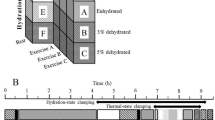Abstract
The effects of elevating plasma osmolality (P osm) on thirst ratings was studied in eight dehydrated males during exposure to 4°C. On two occasions, subjects were dehydrated (DH; 3–4% body mass) via 90 min exercise-heat exposure and overnight fluid restriction (day 1). On a third occasion, subjects were exposed to heat but were given fluid (EU). On day 2, subjects consumed NaCl (NaCl; 0.1 g NaCl kg−1 body mass in 500 ml H2O; DH only) or Placebo (P; 500 ml H2O; DH and EU). Subjects stood for 30 min at 24°C and for 45 min at 4°C (75 min post-dose). P osm was elevated (P < 0.05) 30 and 75 min after NaCl administration in DH + NaCl versus DH + P and EU + P treatments. Thirst ratings remained elevated (P < 0.05) in the DH + NaCl treatment 30 min after dosing and 45 min at 4°C versus DH + P and EU + P. Attenuation of thirst when dehydrated in the cold can be over-ridden by increasing P osm.


Similar content being viewed by others
References
Armstrong LE, Soto JA, Hacker FT Jr, Casa DJ, Kavouras SA, Maresh CM (1998) Urinary indices during dehydration, exercise, and rehydration. Int J Sport Nutr 8:345–355
Atkinson G (2001) Analysis of repeated measurements in physical therapy research. Phys Ther Sport 2:194–208. doi:10.1054/ptsp.2001.0071
Cheuvront SN, Carter R, Castellani JW, Sawka MN (2005) Hypohydration impairs endurance exercise performance in temperate but not cold air. J Appl Physiol 99:1972–1976. doi:10.1152/japplphysiol.00329.2005
Costill DL, Fox EL (1969) Energetics of marathon running. Med Sci Sports 1(2):81–86
Edwards DG, Gauthier AL, Hayman MA, Lang JT, Kenefick RW (2006) Acute effects of cold exposure on central aortic wave reflection. J Appl Physiol 100:1210–1214. doi:10.1152/japplphysiol.01154.2005
Engell DB, Maller O, Sawka MN, Francesconi RP, Drolet LA, Young AJ (1987) Thirst and fluid intake following graded hypohydration levels in humans. Physiol Behav 40:229–236. doi:10.1016/0031-9384(87)90212-5
Freund BJ, Sawka MN (1996) Influence of cold stress on human fluid balance. In: Marriott BM, Carlson SJ (eds) Nutritional needs in cold and high altitude environments. National Academy Press, Washington DC, pp 161–179
Greenleaf JE (1982) Dehydration-induced drinking in humans. Fed Proc 41:2509–2514
Greenleaf JE (1992) Problem: thirst, drinking behavior, and involuntary dehydration. Med Sci Sports Exerc 24:645–656. doi:10.1249/00005768-199206000-00007
Jackson AS, Pollock ML (1978) Generalized equations for predicting body density of men. Br J Nutr 40:497–504. doi:10.1079/BJN19780152
Kenefick RW, Hazzard MP, Mahood NV, Castellani JW (2004a) Thirst sensations and AVP responses are attenuated when hypohydrated at rest and during exercise-cold exposure. Med Sci Sports Exerc 36:1528–1534. doi:10.1249/01.MSS.0000139901.63911.75
Kenefick RW, Mahood NV, Hazzard MP, Quinn TJ, Castellani JW (2004b) Hypohydration effects on thermoregulation during moderate exercise in the cold. Eur J Appl Physiol 92:565–570. doi:10.1007/s00421-004-1079-4
Kenefick RW, O’Moore KM, Mahood NV, Castellani JW (2006) Rapid IV versus oral rehydration: responses to subsequent exercise heat stress. Med Sci Sports Exerc 38:2125–2131. doi:10.1249/01.mss.0000235358.39555.80
Moses AM, Miller M (1971) Osmotic threshold for vasopressin release as determined by saline infusion and by dehydration. Neuroendocrinology 7:219–226. doi:10.1159/000121970
O’Brien C, Young AJ, Sawka MN (1998) Hypohydration and thermoregulation in cold air. J Appl Physiol 84:185–189
Phillips PA, Rolls BJ, Ledingham JG, Forsling ML, Morton JJ (1985) Osmotic thirst and vasopressin release in humans: a double-blind crossover study. Am J Physiol 248:R645–R650
Ramanathan NL (1964) A new weighting system for mean surface temperature of the human body. J Appl Physiol 19:531–533
Sagawa S, Miki K, Tajima F, Tanaka H, Choi JK, Keil LC et al (1992) Effect of dehydration on thirst and drinking during immersion in men. J Appl Physiol 72:128–134
Salata RA, Verbalis JG, Robinson AG (1987) Cold water stimulation of oropharyngeal receptors in man inhibits release of vasopressin. J Clin Endocrinol Metab 65:561–567
Siri WE (1993) Body composition from fluid spaces and density: analysis of methods. 1961 1. Nutrition 9:480–491
Sobocinska J, Kozlowski S (1987) Osmotic thirst suppression in dogs exposed to low ambient temperature. Physiol Behav 40:171–175. doi:10.1016/0031-9384(87)90203-4
Stachenfeld NS, DiPietro L, Nadel ER, Mack GW (1997) Mechanism of attenuated thirst in aging: role of central volume receptors. Am J Physiol 272:R148–R157
Stricker EM, Callahan JB, Huang W, Sved AF (2002) Early osmoregulatory stimulation of neurohypophyseal hormone secretion and thirst after gastric NaCl loads. Am J Physiol Regul Integr Comp Physiol 282:R1710–R1717
Tran ZV (1997) Estimating sample size in repeated measures analysis of variance. Meas Phys Educ Exerc Sci 1:89–102. doi:10.1207/s15327841mpee0101_6
Thompson CJ, Bland J, Burd J, Baylis PH (1986) The osmotic thresholds for thirst and vasopressin release are similar in healthy man. Clin Sci (Lond) 71:651–656
Wada F, Sagawa S, Miki K, Nagaya K, Nakamitsu S, Shiraki K et al (1995) Mechanism of thirst attenuation during head-out water immersion in men. Am J Physiol 268:R583–R589
Wolf AV (1950) Osmometric analysis of thirst in man and dog. Am J Physiol 161:75–86
Acknowledgments
The authors would like to thank the subjects who donated their time and effort in order to participate in this study. The authors also wish to thank John Conlon for his technical support. Lastly the authors would like to thank Michael N. Sawka for his editorial assistance. The views, opinions and/or findings in this report are those of the authors and should not be construed as official Department of the Army position, policy, or decision unless so designated by other official designation. All experiments were carried out in accordance to state and federal guidelines.
Author information
Authors and Affiliations
Corresponding author
Rights and permissions
About this article
Cite this article
Kenefick, R.W., St Pierre, A., Riel, N.A. et al. Effect of increased plasma osmolality on cold-induced thirst attenuation. Eur J Appl Physiol 104, 1013–1019 (2008). https://doi.org/10.1007/s00421-008-0857-9
Accepted:
Published:
Issue Date:
DOI: https://doi.org/10.1007/s00421-008-0857-9




